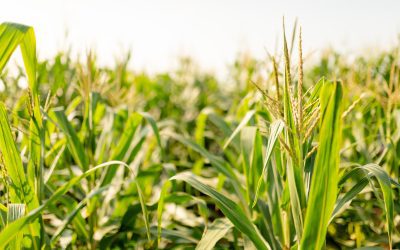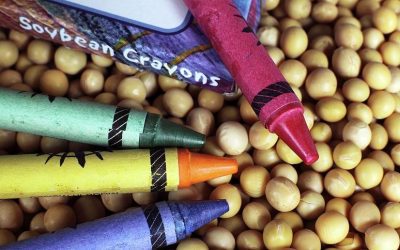The true north of U.S. checkoff groups’ efforts to cultivate fresh customers and expand sales to established ones around the world might be, in the words of Indiana Corn Marketing Council (ICMC) board director David Ring, “You’re always fighting hard to keep the export markets you have while also trying to find new markets.”
Ring began farming in 1963, and his farm stretches into Dubois, Spencer and Warrick counties in southern Indiana. He knows the importance of marketing corn, as well as crop-fed meat. Exports of Indiana corn is largely aided through efforts of the U.S. Grain Council (USGC), whose mission is to develop new export markets for corn and other grains.
In addition to his service on the ICMC Board, Ring is also a USGC board member. Ring said, “By working with national groups like the U.S. Grains Council and others, Indiana corn farmers don’t have to start on the ground floor when working to secure new export markets.”
The checkoff dollars that power the efforts by USGC and ICMC are matched by USDA funding through the Market Access Program (MAP) and Foreign Market Development Program (FMD) to help reach out to overseas customers.
Identifying new and emerging markets has always been important to Indiana Corn, said Steve Howell, senior director of Industry Affairs for ICMC and the Indiana Corn Growers Assoc. (ICGA). But the last three years has reinforced that U.S. farmers should not rely on any one country for its bulk of exports.
In early 2018, former President Donald Trump levied tariffs on Chinese steel and aluminum imports; China retaliated with duties targeting U.S. goods, including soybeans and corn co-products ethanol and distillers dried grains (DDGS). Although Chinese demand is picking up again under the past year’s U.S.-China Phase One trade agreement, all tariffs have not been repealed.
Plus, pointed out USGC Senior Director of Global Programs Cary Sifferath, “When you lose a market like China … you then have to look everywhere you can to find additional markets, new or existing markets.”
Growing markets
In 2012, the U.S.-Colombia Trade Promotion Agreement (COTPA) created opportunity for U.S. agricultural exporters to sell more to the South American nation. Sifferath said much of the corn sold there is used for livestock feed, though some goes into cornstarch processing.

But the ICMC is also supporting programming there to promote co-products, said Senior Director of Grain Production and Utilization Ed Ebert. Marketing corn is more than Hoosier farmers shipping bushels – it’s also about working with USGC to demonstrate the benefits of ethanol in the Colombian fuel supply, and DDGS for livestock growth and development.
Ebert said ICMC is helping promote Colombian imports of U.S.-produced ethanol, rather than just selling raw corn there for local refining. In the last year, liquid fuel sales have faced hard times here and abroad because people stopped driving as much, staying home to avoid spreading COVID-19.
“Exports have come along at just a really wonderful time for both soybeans and corn,” he said.
Since the signing of COTPA, Sifferath said U.S. exports there have continued to climb – the depressing effect of the past year’s pandemic leveled it “a little” going into 2021, but corn was still up 1 percent. “That’s actually pretty good for everything Colombia has gone through with COVID-19,” he added.
Another way ICMC is working directly with the country is through Up River, a program designed to build relationships between Colombian feed mill buyers and those growing and shipping crops from Indiana. In 2018, Ebert said ICMC invested in the effort to take advantage of contacts members had made in 2016 during a visit to Colombia, when they began discussions with the nation’s three largest feed mills in Bogota and Medellin. The idea is to introduce the buyers to Indiana ag producers and port officials along the Mississippi River so they can become better acquainted with where corn and soybeans originate, and U.S. waterways logistics – and so Hoosier farmers can sell more goods directly.
Ebert noted the ICMC, with USGC, is also working to grow corn demand for ethanol in Vietnam. “Now there, we struggle a bit on corn market share,” Sifferath admitted. “The Vietnamese tend to buy more South American corn than U.S. corn, but we do see some U.S. corn going in.”
USGC seeks to partner with local industries for corn use in some growing markets like this. Sifferath explained this can help create stable demand for U.S. stock in certain countries, rather than selling them finished ethanol. Philippines is another such country – it uses domestic sugar in ethanol, then imported corn to help meet its E10 mandate.
Long-term demand for U.S. corn
He said if U.S. officials can work with a foreign government to help it enact policies to increase ethanol use that will hopefully encourage long-term demand for U.S. corn. Similarly, the U.S. is working in India to try to promote adoption of a nationwide ethanol mandate. The country can now only refine imported feedstock like corn for industrial-use ethanol; sugar cane goes into consumer-use ethanol. A mandate would help bump that volume, and the need for corn.

President and farmer from Anderson, Ind, Joshua Miller – also USGC secretary-treasurer – said USGC is in final stages of approval to open a brick-and-mortar office in India. He pointed out the organization has been after this for many years and is excited by its potential. “It’s a huge country, it’s one of the highest-populated countries on Earth, and we’re going to have an office in-country,” he enthused.
Sales of ethanol co-product DDGS from the U.S. have picked up in Vietnam, Indonesia and Thailand since 2017. Vietnam has become the second-largest market for such exports behind Mexico, with a growing feed and livestock industry, Sifferath said. USGC has staff on the ground to work with the livestock and aquaculture industries to grow their imports and sending U.S. farmers on trade missions to explain about corn production and quality.
Miller described Southeast Asia as “a phenomenal success story” for growth in U.S. corn sales, particularly Vietnam and Indonesia. When African swine fever (ASF) decimated the hog herd in Vietnam, he said USGC was there to support producers switching over to poultry production.
“Our guys were there with (corn) nutritional values; our guys were there with feed rations; our guys were there with support,” he said.
Central American nations such as Guatemala, Costa Rica, Honduras and Panama continue to be growing markets for U.S. corn exports despite the leveling effect of COVID-19, said Sifferath. Exports to North African countries Egypt, Tunisia and Morocco are promising too; in fact, he said the United States used to supply 80 percent of the corn import share in Egypt before 2007, when Ukraine became a player.
USGC is working with cornstarch manufacturers in Egypt to try to increase U.S. corn sales again – and efforts are paying off to show how higher starch yield from U.S. stock offsets its higher price. There is also momentum to sell feed corn into Egypt’s growing poultry sector, partly by working with state organizations to build port receiving and storage facilities.
Of course, “the fact that Ukraine corn is in their back door is always going to be a struggle” because of the lower price of that product, Sifferath noted.
Value-added exports
For Indiana farmers, Ring said there are two forms of crop export: raw commodities, and value-added products such as ethanol, DDGS – and meat. After all, being able to sell meat and poultry products fed Indiana soy and corn also works to “move the pile” too.
The U.S. Meat Export Federation’s (USMEF), the ICMC, ISA and USA Poultry and Eggs Export Council (USAPEEC) have been promoting pork and poultry heavily to emerging markets in Central America, and there is also work on touting U.S. meat in India and Africa. Meat and egg sales are a “shining light” for corn and soy exports, Ring noted, because the United States is one of the lowest-cost producers of pork and poultry in the world. There is always room for growing exports for additional uses of corn.
Sifferath said the industry is seeing expansion of industrial use of ethanol in manufacturing hand sanitizer after the past year, for one. There are also growing applications for bioplastics and other renewable materials made of corn.
A return to China
One larger, longer-established market is presenting some emerging opportunities for more traditional crop usage. USMEF is working to sell more fresh chilled pork to China and build a preference for U.S. supply. Too, this importing juggernaut represents reinvigorated exports for U.S. crop as livestock feed, said Ed Ebert.
Three factors have converged to make 2020-21 bumper marketing years for corn sales to China. One is Chinese producers working to reestablish the nation’s pork inventory after cases of ASF first found in 2018 led to mass hog slaughter to stop its spread. Another, said Sifferath, are changes in China to update its pork production biosecurity, including the outlawing of human food waste for hogs, to eliminate that vector of reintroduction of ASF. Formulated feed must replace that estimated 30 million tons of lost feed, and so a higher percentage of corn – and soy meal – is being used in rations.

“They’ve really made significant investments in modernization and updating facilities, and African swine fever has basically wiped out the small-scale pig industry in that country,” Ebert said, explaining Chinese pork farrowing and finishing is trending more toward large U.S.-style facilities.
The third factor has been the Phase One trade deal. Last summer, Sifferath saw China begin buying large volumes of U.S. corn and continuing into the current marketing year. The country is set to overtake Mexico as the United States’ largest customer in 2021.

Here and in other markets, Sifferath noted USGC wouldn’t be able to do its work without the support of partners such as ICMC and its member farmers and agribusinesses. The funding helps it maintain staff in other countries and work toward overcoming global trade barriers, and individuals’ willingness to travel and promote U.S. ag goods is invaluable in spreading goodwill and data to buyers.
Policy and Lobby work
Checkoff funds are spent by ICMC toward on-the-ground marketing in these and many other countries. And, while those dollars cannot, by law, fund the governmental policy work of ICGA, ICGA does carry out complementary efforts to ICMC – including lobbying for increased federal spending to pair with checkoff marketing funds.
Steve Howell said ICGA also advocates on behalf of Indiana producers for favorable terms in free trade agreements – such as COTPA and the more recent U.S.-Mexico-Canada Agreement that replaced the longstanding North American Free Trade Agreement (NAFTA). When there was first talk about overhauling NAFTA a few years ago, he explained the Indiana corn policy group worked with a delegation at the federal level to stress the importance of Canadian and Mexican export markets for the state’s ag goods.
He said ICGA also champions favorable policies for corn producers through “corn in all forms. If Indiana pork products are being exported, they’re carrying Indiana corn products with them.”
ICGA lobbies for better-funded highways, waterways and other infrastructure at the state and federal levels; and assists the U.S. to meet or overcome wariness of ag biotech that can hurt sales in ag destination markets. These are two issues Howell said aren’t always thought of in connection to a state crop organization – but are really relevant.
For instance, ICGA has long lobbied for funding to upgrade locks and dams and to dredge the lower Mississippi to allow larger and heavier-laden vessels to safely load out for export shipping. Last month’s six-day blockage of the Suez Canal by a container ship stuck in a shallow sandbar was a madeto-order illustration of the importance of updated waterways maintenance.
Behind all of Indiana Corn’s promotion and policy efforts is “just that constant drumbeat of ‘we’ve got to find new markets for our products,’” Howell added.



